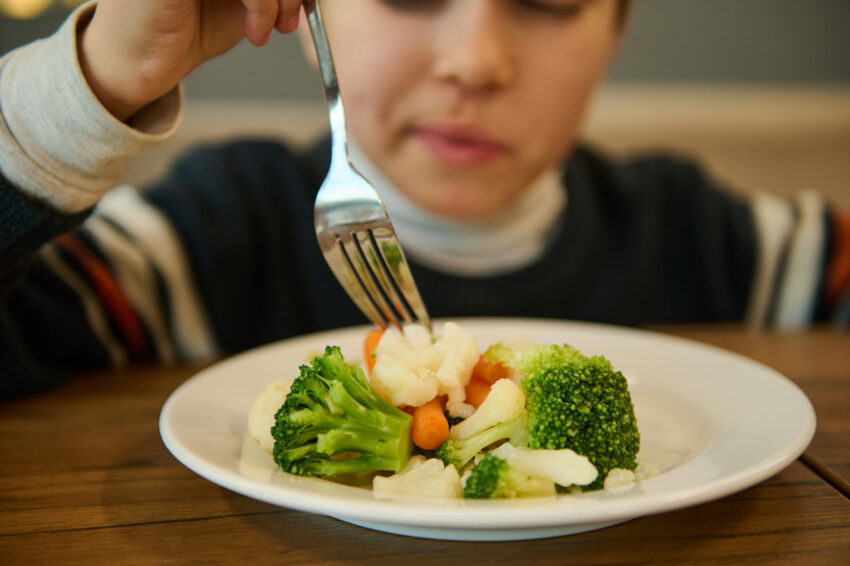
Share On Social!
Nutritious food is an essential part of a healthy lifestyle for children.
However, a February 2023 CDC report shows that many children ages 1-5 are not eating fruits and vegetables daily and are regularly drinking sugary beverages.
“In 20 states, more than one half of children did not eat a vegetable daily during the preceding week. In 40 states and the District of Columbia, more than one half of children drank a sugar-sweetened beverage at least once during the preceding week,” according to the CDC.
Let’s dive deeper and find out the state of diets among Latinos and all children, the role of healthy food access, and how we can create healthier food environments for children.
The State of Children’s Fruit and Vegetable Consumption
The new CDC report paints a grim picture of children’s diets.
With children in need of specific nutrients to support their growth and development, 1 in 3 (32.1%) children did not eat a daily fruit, nearly half (49.1%) did not eat a daily vegetable, and more than half (57.1%) drank a sugary dink at least once.
Recommendations for fruit and vegetable intake range from 1-2 cups for fruit and 1-3 cups for vegetables for children based on their age, gender, and level of physical activity.
Results from the report found that 33.6% of Latino children do not consume the enough fruit while 57.7% didn’t consume enough vegetables for daily intake.
67.2% of Latino children also reported to have consumed one sugary drink weekly.
The percentage of children who did not eat a daily fruit or vegetable was highest among non-Hispanic Black children (50.7% fruit 64.8% vegetables) and lowest among non-Hispanic White children (33.6% fruit 53.7% vegetable).
Drinking a sugar-sweetened beverage at least once during the preceding week ranged from 47.5% among multiracial non-Hispanic children to 71.7% among Black children.
“Compared with children living in food-sufficient households, those living in households with marginal or low food sufficiency were less likely to eat either a daily fruit or vegetable and were more likely to consume sugar-sweetened beverages during the preceding week,” according to the CDC.
Latino Children’s Lack Access to Nutritious Food
Latinos and other minority families face systemic barriers to healthy food access.
A Salud America! research review noted that fast food restaurants and corner stores outnumber supermarkets and farmers’ markets in many Latino neighborhoods.
“This results in overconsumption of unhealthy foods, and more risk of obesity,” according to the research review.
Latino and Black households are more likely to suffer food insecurity (16.2% and 21.2%, respectively) than the national average (11.1%), according to a Salud America! resource.

The COVID-19 pandemic also worsened food and nutrition security of communities of color.
Food insecurity means a lack of reliable access to a sufficient quantity of affordable, nutritious food. Nutrition security means “having consistent access to and availability and affordability of foods and beverages that promote well-being, while preventing — and, if needed, treating — disease,” according to researchers.
“While national food security programs are in place to help Americans access safe, nutritious and enjoyable foods, there’s a gap,” according to a recent nutrition essay in the Washington Post. “The ‘nutritious’ part often gets left behind, since programs may focus on providing an appropriate amount food or calories rather than ensuring the food is nutrient-dense.”
Improving Children’s Nutrition and Healthy Food Access
Systemic change is a main way to create healthier food environments for children.
A Salud America! research review suggests healthy food financing initiatives to boost access to healthy, affordable foods. This happens when supermarkets and farmers’ markets get certain incentives to develop their businesses in underserved areas.
Universal free school meals can help, too.
“Research shows that students who participate in the school meal programs consume more whole grains, milk, fruits, and vegetables during meal times and have better overall diet quality, than nonparticipants,” according to the CDC.
Also, more marketing of healthy foods, and less of junk foods, can help spur desirability.
US food and beverage companies disproportionately target Black and Latino consumers with advertising for high-calorie, low-nutrient products, including candy, sugary drinks, and snacks. Sugary drinks are the most common children’s beverages offered at the top 200 restaurant chains in 2019 and 2021.
“The continued targeted advertising for high-calorie, low-nutrient products to these vulnerable communities is simply unacceptable. Hispanics deserve access to, and promotion of, healthier foods and drinks,” said Dr. Amelie G. Ramirez, director of Salud America! at the Institute for Health Promotion Research at UT Health San Antonio.
Federal agencies also can help improve nutrition – with your help.
For example, 15,238 people like you just told USDA they support its updated nutrition standards for the Special Supplemental Nutrition Program for Women, Infants, and Children (WIC) food packages.
USDA needs your comment today on its proposal to enable WIC participants to shop online for food, a move to increase access to nutritious foods.
“Overall, the proposed changes would advance nutrition security by improving the WIC shopping experience and ensuring that WIC participants have equitable access to nutritious foods,” according to the USDA.
Food and Health Equity in Your Community
What food issues are hurting your community?
Check out the new Food Equity Opportunity Map to see healthy food access issues in your area and where improving access would make the greatest impact.
And don’t stop there.
Download a Salud America! Health Equity Report Card!
The report card will show you how many local children live in poverty and food deserts, how many have low food access, and how many get SNAP food benefits. Then you can compare it to your state and to the country.
Email your Health Equity Report Card to community leaders, share it on social media, and use it to make the case to address food insecurity where help is needed most!
GET YOUR HEALTH EQUITY REPORT CARD!
Explore More:
Healthy FoodBy The Numbers
1
Supermarket
for every Latino neighborhood, compared to 3 for every non-Latino neighborhood



